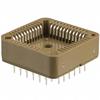The growing demand for electric vehicles requires the development of automated car charging methods. At the moment, the process of charging an electric car is completely manual, and that requires physical effort to accomplish the task, which is not suitable for people with disabilities. Typically, the effort in the automation of the charging task research is focused on detecting the position and orientation of the socket, which resulted in a relatively high accuracy, 5 mm, and 10 degrees. However, this accuracy is not enough to complete the charging process. In this work, we focus on designing a novel methodology for robust robotic plug-in and plug-out based on human haptics to overcome the error in the orientation of the socket. Participants were invited to perform the charging task, and their cognitive capabilities were recognized by measuring the applied forces along with the movements of the charger. Eventually, an algorithm was developed based on the human's best strategies to be applied to a robotic arm.
翻译:暂无翻译





